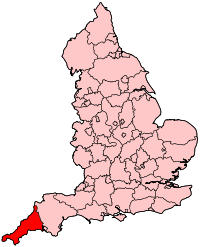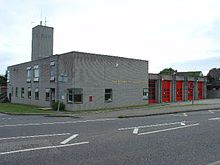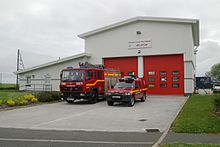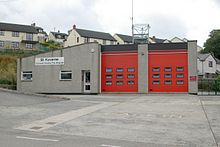- Cornwall Fire and Rescue Service
-
Cornwall Fire and Rescue Service (CFRS) 
Cornwall Fire and Rescue Service (CFRS) areaCoverage Area Cornwall Size 1,376 square miles (3,560 km2) Population 519,400 Operations Formed 1948 HQ Truro Staff 752 Stations 31 Co-responder 4 Stations Chief Fire Officer Des Tidbury Website Cornwall Fire and Rescue Service Fire authority Cornwall Council Cornwall Fire and Rescue Service is the statutory fire and rescue service covering Cornwall in the United Kingdom.
The brigade employs 428 retained firefighters, 201 full-time firefighters, plus over 120 support and administrative staff.[1] Created under the Fire Services Act 1947 as "Cornwall Fire Brigade", the name changed to "Cornwall Fire and Rescue Service" on October 1, 2009,[2] leaving London and Cleveland as the only two UK fire services to use the name "Fire Brigade".
For organisational purposes the Fire Service is divided into three divisions: Eastern, Central and Western. The service is administered by Cornwall Council, headquartered in Truro.
As part of the FiReControl project, Cornwall Fire and Rescue Services' control room was planned to switch over to the regional control centre in Taunton, Somerset. Originally scheduled to take place in July 2010, the cutover date was revised to January 2012,[3] however the plan was scrapped in December 2010.[4]
Contents
Fire stations
Cornwall Fire and Rescue Service operates 31 fire stations,[5] of which two are crewed day and night (wholetime), five are day-crewed (Monday to Sunday, 07:00 to 19:00) and the remainder are crewed by retained firefighters, who live near to their fire station and can arrive there within five minutes of a call being received. The breakdown of stations is as follows:
- 2 wholetime/retained stations
- 5 day-crewed stations/retained stations
- 24 retained stations
The Service operates a variety of fire appliances including water rescue ladders, water rescue tenders, light 4x4 tenders and pumps, as well as specialist vehicles for operational support, marine support, environmental support and command support.
Wholetime/retained stations
Camborne (Water Rescue Ladder, Water Rescue Tender, Rescue Tender, Line Rescue Unit, Incident Response Unit);
Falmouth (2 Water Rescue Ladders, Light 4x4 Pump, Operational Support Unit, Marine Support Unit, Boat)
Day-crewed/Retained stations
Penzance (Water Rescue Ladder, 4x4 Water Rescue Tender, Light 4x4 Pump, Environmental Support Unit )
Newquay (Water Rescue Ladder, Water Rescue Tender, Aerial Ladder Platform x2, High Volume Pump x2, USAR Derobing Unit);
St. Austell (Water Tender Ladder, 4x4 Water Rescue Tender, Operational Support Unit);
Truro (Water Rescue Ladder, 4x4 Water Rescue Tender, Command Support Unit, Aerial Ladder Platform)
Bodmin (Water Rescue Ladder, Water Rescue Tender, Rescue Tender, Line Rescue Unit, Light 4x4 Pump, Incident Response Unit, Environmental Support Unit)
Retained stations
Helston (Water Rescue Ladder, Light 4x4 Pump (co-responder), Water Carrier);
Mullion (Water Rescue Ladder, Light 4x4 Pump (co-responder));
Perranporth (Water Rescue Ladder, Light 4x4 Pump);
Redruth (Water Rescue Ladder, Light 4x4 Pump);
St. Ives (Water Rescue Ladder, Water Rescue Tender, Light 4x4 Pump);
St. Just (Water Rescue Ladder, Light 4x4 Pump, Command Unit);
St. Keverne (Water Rescue Ladder, Light 4x4 Pump (co-responder))
Fowey (Water Rescue Ladder, Light 4x4 Pump);
Mevagissey (Water Rescue Ladder, Light 4x4 Pump);
Padstow (Water Rescue Ladder, Light 4x4 Pump);
Polruan (Water Rescue Ladder, Light 4x4 Pump);
St. Columb (Water Rescue Ladder, Light 4x4 Pump);
St. Dennis (Water Rescue Ladder, Light 4x4 Pump, Welfare Unit);
St. Mawes (Water Rescue Ladder, Light 4x4 Pump, co-responder car)
Bude (Water Rescue Ladder, Water Rescue Tender, Light 4x4 Pump);
Callington (Water Rescue Ladder, Light 4x4 Pump);
Delabole (Water Rescue Ladder, Light 4x4 Pump);
Launceston (Water Rescue Ladder, Water Rescue Ladder);
Liskeard (Water Rescue Ladder, Water Rescue Tender, Water Carrier);
Looe (Water Rescue Ladder, Light 4x4 Pump, Limited Access Vehicle (LAV));
Lostwithiel (Water Rescue Ladder, Light 4x4 Pump);
Saltash (Water Tender Ladder, Water Rescue Tender);
Torpoint (Water Rescue Ladder, Light 4x4 Pump);
Wadebridge (Water Rescue Ladder, Light 4x4 Pump, Water Carrier)
Co-responder stations
Cornwall Fire and Rescue Service works in partnership with South Western Ambulance Service to provide emergency medical cover to area of Cornwall. These are areas that have been identified as having a greater need for ambulance cover. The aim of a co-responder team is to preserve life until the arrival of either a Rapid Response Vehicle (RRV) or an ambulance.[6] Co-responder vehicles are equipped with oxygen and automated external defibrillator (AED) equipment.
The fire stations operating as co-responders are:
- Helston
- Mullion
- St. Keverne
- St. Mawes
Workshop and stores
The Service workshop and stores are located at the rear of Camborne fire station. The workshop contains three pit bays, one HGV ramp bay, one car and van ramp bay and a spraying bay. The setup enables up to six vehicles to be in the workshop at any one time.
The workshop also houses the stores, including both clothing and equipment, and holds over 7,000 items including operational equipment like branches and radios, and clothing from tunics to dress uniforms. This is always updated to ensure any equipment or clothing needed is ready to be dispatched immediately to wherever it is needed.
The workshops also maintain all of the operational equipment, from repairing the lengths of hoses to the breathing apparatus (BA) sets; this is carried out by the specialist “hose shop” also located on-site.
Emergency repair is available 24/7 through an “on call” system where mechanics take turns to provide 24-hour service if an appliance or equipment becomes defective.
Fire appliances
Cornwall Fire and Rescue Service uses a variety of front-line and specialist appliances:
Water rescue ladder (WRL)
Also referred to as the 'first away' appliance, it is usually mobilised to every incident. It carries an array of equipment including crash rescue equipment (CRE), breathing apparatus, water rescue equipment and a thermal imaging camera.
There are occasions when a Water Tender would instead be mobilised first to keep the Water Tender Ladder available; the Water Tender may attend incidents where a house is flooded or persons have locked themselves out.
Their major capabilities include pumping up to 2,000 litres (440 gallons) per minute between two locations. It has a storage capacity of 1,850 litres (396 gallons). The pump carries a 13.5 metre (44 ft) ladder, a short extension ladder and a roof ladder.
Water rescue tender (WRT)
Also referred to as the "second away". These appliances are broadly similar to the Water Tender Ladders, but carry a different range of equipment, with ladders up to 10.5 metres (34 ft). They are not the primary responder to a road traffic collision, despite carrying hydaulic cutting equipment. The water tenders are used to support water tender ladders at fires and to attend miscellaneous calls. Some Second Away appliances have the advantage of being 4x4 and sometimes they will be the first appliance to respond in harsh weathers such as snow, fire control may also mobiles the second away to turn out first if the incident is situated in a field and the all wheel drive would be necessary. A water tender, like its counterpart, is capable of carrying up to six firefighters.
Light 4x4 appliances
Light appliances are based on a 4x4 chassis and designed with off-road capability. These appliances would be requested, or mobilised with the main appliance, to incidents that may be difficult to reach - either due to narrow roads or the terrain. The co-responder units tend to be the light 4x4 appliances allowing a faster response time, and to keep the main appliance available. These vehicles have a lightweight pump mounted on the back which feeds either a hosereel or 75 mm hose.[7][unreliable source?] They can also be fed by a small on-board water tank or from a hydrant.
The 4x4 appliances have the capability to carry a crew of up to four. Some carry four sets of breathing apparatus in the cab. The appliance carries a limited amount of equipment (due to its size). These vehicles tend to be Toyota Hiluxes, Vauxhall Bravas or Landrovers.
Command support unit
The Command Support Unit is a Mercedes-Benz 814D-derived vehicle as well as 2 modified Mercedes Sprinter Vans. They are mobilised to any incident over 4 pumps or by request of the incident commander. The CSU's carries specialist equipment to be able to effectively take control of any situation. In the rear of the unit are specialised computers with links to chemical identification databases and aerial maps. The command support units are also fitted with satellite systems and external Television screen which can show maps to senior officers viewing from outside
The vehicle's are crewed by both officers and firefighters and are able to communicate with fire control as well as officers and firefighters on the fire ground. It is also acts as a booking in centre for arriving crews.
Rescue tender'S (RT)/ Line Rescue Unit's (LRU)
The Rescue tender's are based on a Mercedes Atego Chassis. The RT's are mobilised by the incident commander or though a pre-determined attendance. It carries specialised cutting and spreading equipment, lifting gear, supporting tools, and lighting units.The RT is also fitted with a heavy duty winch mounted at the front of the vehicle which enables it to pull or support objects. It is crewed by specially-trained wholetime and retained firefighters from Camborne and Bodmin fire stations.
The two Line Rescue Units (LRU's) are based on a Mercedes-Benz 1124 4x4 chassis with a Hiab crane on the rear of the vehicle and a Mercedes Atego chassis. Both units carry specialist rope rescue equipment as well as powerful winches and lighting units. The LRU also carries confined space packs which are used when casualties are trapped in a small space such as a mine. AS the same with the RT's heavy duty winches are mounted on the vehicles to help in pulling or supporting an object.
Operational Support Vehicle (OSV)
The 2 operational support vehicles are based on mercedes sprinter chassis and are based at Falmouth and St.Austell fire stations. They provide extra equipment such as extra breathing apparatus cylinders as well as dry suits and water/mud inflatable rescue platforms, because of this water rescue capability they are usually sent as part of the attendance to any water incident. They can also act as a BA command and entry point for larger incidents.
Welfare unit
The welfare unit is based on a specially modified Mitsubishi Fuso chassis. The unit comprises a small kitchen area in one locker with a fridge and hot water urn. Hand washing facilities in another locker and ample cupboard space in another's. At the rear there is also 2 unisex toilets. This unit generally goes to large fires where crews are going to be in attendance for a long period of time as it allows the firefighters and officers to have a short brake, and serves hot and cold refreshments and provides sanitary needs for the crews. This unit is based at St.Dennis fire station
Environmental support unit (ESU)
The 2 environmental support units are based on a Vauxhall Movarno chassis and are based at Bodmin and Penzance fire stations. These units carry specialist equipment to deal with chemical incidents such as spillages. They carry extra gas tight suits (GTS), oil absorbent granules, dammit mats and paste and over-drums for sealing leaking chemical drums. They are usually part of the predetermined attendance to all incidents involving chemical incidents.
Limited access vehicle (LAV)
The Limited Access Vehicle or LAV is based on a Kawasaki Mule and is stationed at Looe fire station. Then vehicle was adapted by brigade workshops to carry a portable pump, ladder, hoses and branches and 2 sets of BA. The LAV is designed to navigate around the very small streets of Polperro and is towed to the incident by a Toyota Hilux L4P.
Mutual assistance
The Fire and Rescue Services Act 2004, gives fire services the power to assist other fire services or fire authorities in what is known as mutual assistance.[8]
The fire services that adjoin Cornwall are as follows:
Notable incidents
- Torrey Canyon disaster, 18 March 1967:
This incident saw possibly the largest fire brigade attendance in UK history: 78 different brigades (with over 200 appliances, 147 of which responded from London Fire Brigade) and 38 different military units spread detergent and pumped out contaminated water. The cleanup lasted months and the brigades stayed on-site throughout working 24/7. Cornwall Fire Brigade set up a workshop near the Lizard to maintain the appliances on-site whilst refilling them and portable pumps with petrol. In the height of the operation over 1,600 personnel were on scene.
- Falmouth dock fire, 18 January 2003:
A fire broke out at the Queens Wharf dock and spanned 360 ft; the dock was well alight. 11 appliances attended as well as a fireboat, which surveyed the situation from the bay.
- Boscastle flooding, 16 August 2004:
The first call came into Fire Control in Truro at 16:00 to report a person trapped in a car with the water rising. At 17:30 a major incident was declared and search and rescue helicopters from RNAS Culdrose along with other helicopters throughout the Southwest assisted the fire brigade and Coastguard in evacuating people. 25 appliances attended the scene along with a further 22 for relief purposes. Although the brigade could not do anything with regards to the pumping out of water they assisted searching for persons trapped in their cars and homes and helped bring them to safety via the RNAS search and rescue helicopter. The brigade also carried out salvage work once the water had receded. The brigade were in attendance for a number of days with nearly the whole of the brigades pumping resources in attendance as either first response or as a relief crew.
- Penhallow Hotel Disaster, 18 August 2007:
The first 999 call was received at 00:17; crews from Newquay were first on scene and requested further appliances to attend. The fire consumed all three floors of the hotel and three people died at the scene. 25 appliances attended with support appliances; Devon and Somerset Fire and Rescue Service also provided a turntable ladder, officers and USAR assistance. The cause of the fire is believed to be arson, but no one has been charged. As of the outcome to the incident questions were raised over the retained staffing levels at Newquay fire station and the brigades lack of operational aerial ladder platforms.
- Athena Ship Fire, 27 October 2010:
The Fish Factory ship the Athena caught fire 230 miles of the southwest coast of the isles of Scilly. 98 of the 111 crew were forced to abandon ship into the life rafts, these were picked up by the container ship the Vega. The Athena was then taken under tow to Falmouth bay where Cornwall Fire and Rescue's MIRG (Marine Incident Response Group) was then flow out by helicopter to the ship.Once on board the started to fight the fire in the hold of the ship which contained around 600,000 cardboard boxes. However in the early hours of the morning they were forced to evacuate after carbon monoxide levels reached a dangerous level, a couple of firefighters were taken to hospital. The ship is now in control of a salvage team who are finding the best outcome for the ship.
- South Coast Flooding, 17 November 2010:
During the night and the early hours of the 16/17 November torrential rain hit the south coast of Cornwall, the ground became saturated and water began to run off of the surrounding fields into the already overflowing rivers causing many to burst their banks. The worst places hit by the storm were Mevagissey, Lostwithiel, The Glynn Valley, St.Blazey, Portloe, St.Austell and Pentewan. Many places saw 3 to 4 foot of water flooding hundreds of home and shops and causing landslides. Cornwall FRS deployed appliances to the worst hit areas to pump out shops, roads and homes and to assist with salvage work. Around midday Devon and Cornwall police declared the scenes and a Major Incident. Fortunately there were no casualties.
- A+P Falmouth Docks Fire, 17 June 2011:
At around 8:00am a worker was changing over an acetylene cylinder when the tank began to vent and ignited, this in turn ignited other venting tanks. On arrival of the brigade a 300M .[9] cordon was put in place which required surrounding houses and the docks to be evacuated. The brigade extinguished the initial fire but then had to cool the cylinders constantly for 24hrs to prevent the cylinders for exploding due to the heat and pressure build up. In total Cornwall FRS sent 6 pumping appliances, 1 command support unit, 1 operational support unit, 1 welfare vehicle. The incident lasted for 24hrs and required numerous relief crews to attend over night.
Other emergency services
- Cornwall Air Ambulance
- South Western Ambulance Service
- Devon and Cornwall Constabulary
- HM Coastguard
- Royal National Lifeboat Institution (RNLI)
References
- ^ "Facts & Figures". Cornwall County Fire Brigade. http://www.cornwall.gov.uk/index.cfm?articleid=630. Retrieved 29 March 2009.
- ^ http://www.cornwall.gov.uk/Default.aspx?page=7130
- ^ http://www.swfirecontrol.co.uk/whatisfirecontrol.asp
- ^ "Control room scrapping 'will help Devon and Somerset". BBC News. 20 December 2010. http://www.bbc.co.uk/news/uk-england-12043791. Retrieved 21 December 2010.
- ^ "Structure". Cornwall County Fire Brigade. http://www.cornwall.gov.uk/index.cfm?articleid=626. Retrieved 29 March 2009.
- ^ SWAST Fire Co Responders
- ^ http://theccfbforum.proboards66.com/index.cgi?board=appliances&action=display&thread=2 Front Line Appliances
- ^ "Fire and Rescue Services Act 2004". OPSI. http://www.opsi.gov.uk/acts/acts2004/40021--c.htm#13. Retrieved 29 March 2009.
- ^ BBC News Falmouth Dock Fire
Further reading
- Books by Arthur Ivan Rabey:
- 1981: Cornwall's Fire Brigades. St. Columb: I. Rabey
- 1998: Cornwall County Fire Brigade 1948 - 1998: the first 50 years. St. Columb: I. Rabey
- 2003: The Centenary of St. Columb Fire Brigade, 1903-2003. St Columb: [the Author]
External links
- [http:// Official website]
- Cornwall RFU (Retained Firefighters Union for Cornwall)
England
Avon · Bedfordshire & Luton · Berkshire · Buckinghamshire · Cambridgeshire (Peterborough) · Cheshire · Cleveland · Cornwall · County Durham & Darlington · Cumbria · Derbyshire · Devon and Somerset · Dorset · East Sussex · Essex · Gloucestershire · Greater Manchester · Hampshire · Hereford and Worcester · Hertfordshire · Humberside · Isles of Scilly · Isle of Wight · Kent · Lancashire · Leicestershire & Rutland · Lincolnshire · London · Merseyside · Norfolk · Northamptonshire · Northumberland · North Yorkshire · Nottinghamshire · Oxfordshire · Shropshire · South Yorkshire · Staffordshire · Suffolk · Surrey · Tyne and Wear · Warwickshire · West Midlands · West Sussex · West Yorkshire · WiltshireScotland
Central Scotland · Dumfries & Galloway · Fife · Grampian · Highlands & Islands · Lothian & Borders · Strathclyde · TaysideWales
Northern Ireland
Categories:- Fire and rescue services of England
- Organisations based in Cornwall
Wikimedia Foundation. 2010.




